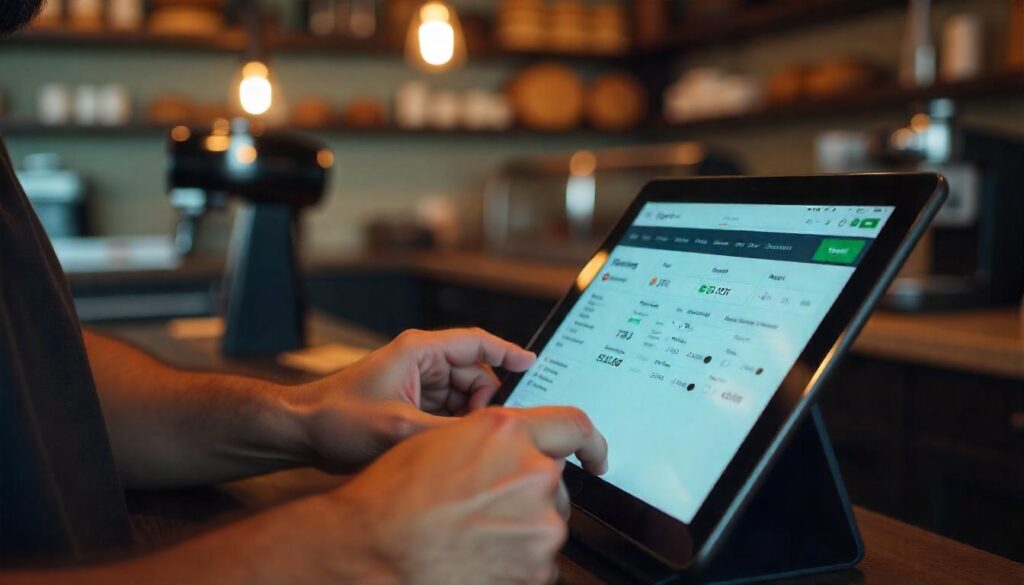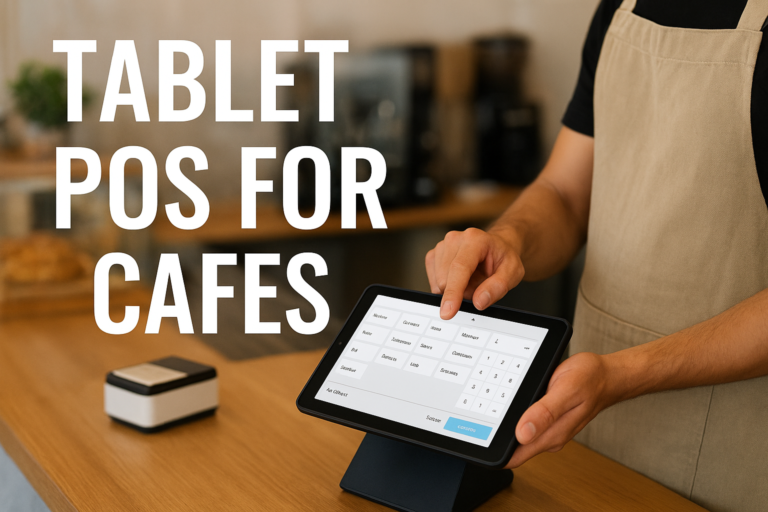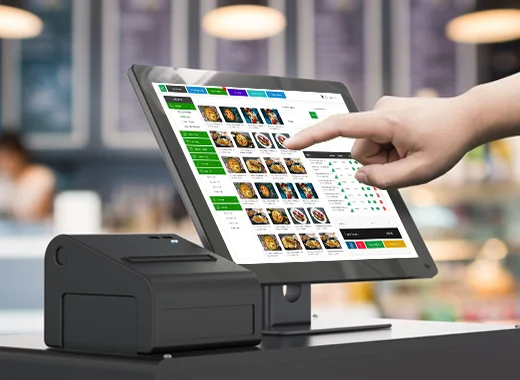Imagine walking into a sophisticated restaurant, where the ambiance is as exquisite as the culinary delights served. As a fine dining establishment, maintaining this elegance while ensuring efficient service is crucial.
This is where a Fine Dining POS System comes into play. You might be wondering how this advanced technology can elevate your dining experience and streamline operations. Well, you’re in the right place to find out. You’ll discover how a Fine Dining POS System not only enhances customer satisfaction but also optimizes your restaurant’s performance.
Prepare to uncover the secrets behind seamless service, increased profitability, and a refined dining experience that keeps guests coming back for more.

What Is A Fine Dining Pos System?
In the world of fine dining, delivering an exceptional experience is key. This involves not only exquisite dishes but also seamless service. A Fine Dining POS System plays a crucial role in achieving this. It is a specialized tool designed to enhance restaurant operations. It offers features tailored to the unique needs of upscale dining establishments.
What Defines A Fine Dining Pos System?
A Fine Dining POS System is not just for processing transactions. It optimizes the workflow from the kitchen to the dining area. It ensures orders are accurate and timely, enhancing customer satisfaction. This system integrates various functionalities to streamline operations. It reduces errors and improves efficiency.
Features Tailored For Fine Dining
Fine Dining POS Systems offer features like table management. They allow staff to track reservations and seat guests efficiently. Menu customization is another key feature. It lets chefs update dishes with ease, accommodating seasonal changes. Inventory management ensures that ingredients are always in stock.
Enhanced Customer Experience
These systems focus on delivering a memorable dining experience. They help staff manage customer preferences and special requests. The system stores customer data to personalize future visits. Payment processing is smooth, offering multiple options for guests.
Streamlined Operations
A Fine Dining POS System improves communication between staff. Orders are transmitted directly to the kitchen, minimizing errors. It helps in managing staff schedules, ensuring optimal service levels. Reporting features provide insights into sales and customer trends.
Key Features Of Fine Dining Pos
A Fine Dining POS system is crucial for restaurant efficiency. Key features enhance operations and improve customer experiences. These systems cater to unique needs of fine dining establishments. Explore the essential features that make these systems valuable.
Table Management
Effective table management ensures smooth service flow. POS systems offer reservation tracking and table assignments. Staff can quickly identify available tables and manage seating. This reduces wait times and enhances guest satisfaction.
Customizable Menus
Customizable menus allow restaurants to adapt to changing trends. POS systems enable easy updates to menu items and prices. Restaurants can highlight specials or seasonal dishes effortlessly. This flexibility keeps the menu fresh and appealing to diners.
Order Accuracy
Accurate order handling minimizes errors and enhances service quality. POS systems offer clear communication between staff and kitchen. Orders are sent directly to the kitchen, reducing misunderstandings. This precision ensures guests receive exactly what they ordered.
Payment Integration
Seamless payment integration simplifies transactions for customers. POS systems support multiple payment methods, including credit cards and digital wallets. Fast and secure processing ensures a smooth checkout experience. This efficiency contributes to overall guest satisfaction.
Benefits Of Implementing A Pos System
Implementing a Point of Sale (POS) system in a fine dining restaurant offers various advantages. It enhances the customer experience, simplifies operations, provides valuable insights, and boosts efficiency. Let’s explore these benefits in detail.
Enhanced Customer Experience
A POS system speeds up order processing. Customers receive quick service. It reduces wait times. Staff can focus more on customer needs. It leads to happier guests. Payment is seamless and secure. It builds trust and satisfaction.
Streamlined Operations
POS systems simplify tasks. They automate billing and inventory checks. Staff can manage reservations easily. It reduces errors in orders. Communication between the kitchen and the waitstaff improves. This keeps operations smooth and organized.
Improved Data Insights
POS systems collect valuable data. They track sales patterns. Managers can identify popular dishes. Insights help in planning menus. They assist in understanding customer preferences. This data guides business decisions effectively.
Increased Efficiency
Efficiency rises with a POS system. Staff work faster with automated processes. It reduces manual tasks. Inventory management becomes accurate. It saves time and resources. This leads to increased productivity.
Choosing The Right Pos System
Selecting an ideal fine dining POS system enhances restaurant efficiency and customer satisfaction. It streamlines order processing, manages inventory, and simplifies billing. A well-chosen system elevates the dining experience and operational workflow.
Choosing the right POS system for your fine dining restaurant can be a game changer. It’s not just about processing payments; it’s about streamlining operations, enhancing customer experience, and even boosting your bottom line. But with so many options out there, how do you pick the one that fits your unique needs?
Assessing Restaurant Needs
Start by understanding what your restaurant truly requires. Do you need a system that handles table reservations, menu management, or staff scheduling?
Think about the challenges you face daily. For instance, if order accuracy is a problem, a POS system with detailed order management could be a lifesaver.
Talk to your team and gather their input. They are the ones who will use the system day in and day out, and their insights can be invaluable.
Evaluating Software Options
Once you’ve identified your needs, explore the software options available. Some systems specialize in fine dining, offering features like wine management and coursing.
Compare user interfaces. A clunky interface can slow down service, so test a few to see which feels intuitive.
Look for software that integrates with existing tools you use. For example, if you use specific accounting software, ensure your POS can sync with it to save time on bookkeeping.
Considering Hardware Requirements
Don’t overlook hardware when choosing your POS system. Do you need handheld devices for waitstaff, or will a stationary terminal suffice?
Consider the layout of your restaurant. A large dining area might benefit from multiple terminals to avoid bottlenecks at checkout.
Check the durability of hardware options. In a bustling restaurant environment, robust devices can withstand spills, drops, and constant use.
The right POS system can transform how your restaurant operates. By carefully assessing your needs, evaluating software options, and considering hardware requirements, you set yourself up for success. What features are non-negotiable for you?
Integration With Other Systems
Fine Dining POS System seamlessly connects with other systems, enhancing operational efficiency. It effortlessly integrates with inventory, accounting, and reservation tools, ensuring smooth transactions and accurate data management. This connectivity simplifies processes, allowing staff to focus on providing exceptional dining experiences.
Integrating a Fine Dining POS system with other systems can transform your restaurant’s operations into a seamless and efficient experience. It’s not just about processing payments; it’s about creating a cohesive ecosystem that enhances every aspect of your business. Imagine a world where your inventory updates automatically after every sale, your customer relationship management is personalized and effective, and your online reservation system is always in sync. That’s the power of integration, and it’s within your reach.
Inventory Management
Managing inventory in a restaurant can be a daunting task. With a POS system integrated with inventory management software, you can track stock levels in real-time.
This means automatic updates whenever a dish is sold or an ingredient is used. You’ll have fewer mistakes and less wastage. Picture this: you’re preparing for a busy night and realize you’re running low on a key ingredient—no last-minute panic because your POS system already alerted you earlier.
Customer Relationship Management
How well do you know your customers? A POS system integrated with CRM software helps you understand them better.
You can keep track of their favorite dishes, dining habits, and preferences. This allows you to tailor promotions and offers specifically to them, making them feel valued and appreciated. Next time they walk through your door, you’ll be ready to offer them exactly what they love.
Online Reservations
Online reservations are a convenience that customers love. Integrating your POS system with your reservation platform ensures that your tables are managed efficiently.
No more double bookings or confusion over seating arrangements. Guests can book their preferred time slot, and your staff can focus on delivering excellent service. Have you ever thought how seamless your operations could be with such integration?
Integration can be the key to unlocking potential in your restaurant. Are you ready to take your dining experience to the next level?
Training Staff For Optimal Use
Fine dining establishments benefit greatly from training staff to use the POS system effectively. Proper training ensures smooth operations, leading to improved customer service. Staff become confident in managing orders, payments, and reservations, which enhances the dining experience.
Training staff to use a Fine Dining POS system effectively is essential for ensuring a seamless dining experience. The goal is to empower your team, enabling them to operate the system confidently and efficiently. This not only enhances customer satisfaction but also boosts overall productivity in your restaurant.
Comprehensive Training Programs
Invest in comprehensive training programs that cover all aspects of your POS system. Ensure every team member, from servers to managers, understands the system’s features and functions. Consider using a mix of hands-on practice and instructional videos to cater to different learning styles.
Break down training into manageable sections. Focus on key features that staff will use daily, such as order entry and payment processing. Make sure there’s room for questions and clarification, fostering a supportive learning environment.
Include mock scenarios to simulate real-life situations. This approach builds confidence and encourages staff to think on their feet. Plus, it prepares them to handle unexpected challenges smoothly.
Continuous Support
Training doesn’t stop after the initial session. Provide continuous support to ensure staff feel confident using the POS system. Establish a system for ongoing learning, such as regular refresher courses or updates on new features.
Encourage an open-door policy where staff can ask questions without hesitation. This promotes a culture of learning and growth within your team. It also helps identify common issues, allowing you to address them promptly.
Consider assigning a POS system champion within your team. This person can serve as a go-to resource for quick help and guidance. They can also share tips and tricks to improve efficiency and reduce errors.
Have you ever wondered how a simple question during training could save hours of troubleshooting later? By equipping your staff with the right knowledge and support, you lay the foundation for a seamless dining experience.
Future Trends In Fine Dining Pos
The world of fine dining is evolving rapidly. Point of Sale (POS) systems play a crucial role in this transformation. New trends and technologies are shaping the future of fine dining POS. Restaurants are embracing these advancements to enhance customer experience and streamline operations.
Ai And Machine Learning
Artificial Intelligence (AI) is making waves in fine dining POS systems. AI can analyze customer data to personalize dining experiences. Machine learning algorithms predict customer preferences and suggest menu items. This adds a personal touch to dining.
AI also helps manage inventory efficiently. It predicts demand for ingredients and reduces waste. This ensures that restaurants always have fresh ingredients on hand.
Mobile Payment Solutions
Mobile payment solutions are becoming popular in fine dining. They offer convenience and speed. Customers can pay directly from their smartphones. This reduces wait times and enhances customer satisfaction.
Mobile payments also provide additional security. They encrypt transactions, keeping customer data safe. More restaurants are adopting this trend to meet customer expectations.
Contactless Dining Experience
The contactless dining experience is gaining momentum. Customers can order and pay without touching shared surfaces. This trend is appealing in a health-conscious world.
QR codes are a key tool for contactless dining. Customers scan codes to access menus and make payments. This limits physical contact, promoting safety and hygiene.
Contactless dining also speeds up service. It allows staff to focus more on customer care. This improves overall dining experiences.
Case Studies Of Successful Implementations
Fine Dining POS systems have transformed restaurant operations. They provide streamlined processes and enhanced customer service. Many restaurants have successfully implemented these systems. Let’s explore some case studies. These demonstrate how POS systems benefit fine dining establishments.
Case Study 1: The Elegant Bistro’s Transformation
The Elegant Bistro faced challenges in order management. They adopted a modern POS system. This change improved order accuracy and speed. Staff spent less time on manual tasks. Customer satisfaction increased significantly. The system allowed better inventory tracking. Waste and costs were reduced. The restaurant saw higher profits.
Case Study 2: Gourmet Delights’ Efficiency Boost
Gourmet Delights struggled with slow payment processing. They implemented a user-friendly POS solution. Transactions became quicker and more efficient. Guests appreciated the speedy service. The system integrated with their loyalty program. Customer engagement improved. The restaurant noticed an uptick in repeat visits. Operational efficiency was markedly enhanced.
Case Study 3: La Cuisine’s Seamless Integration
La Cuisine wanted better coordination between kitchen and front-of-house. A new POS system provided seamless communication. Orders reached the kitchen swiftly. Errors and miscommunications decreased. Staff could focus on delivering quality service. The restaurant’s reputation for excellence was strengthened. Increased table turnover led to higher revenues.
Case Study 4: The Prime Plate’s Inventory Management Success
The Prime Plate struggled with inventory issues. They adopted a sophisticated POS system. Inventory tracking became precise and reliable. Overstock and shortages were minimized. The system offered detailed sales reports. Management could make informed purchasing decisions. The restaurant’s waste was significantly reduced. Profit margins improved noticeably.

Frequently Asked Questions
What Pos System Do Fine Dining Restaurants Use?
Fine dining restaurants often use POS systems like Toast, Square, or Lightspeed. These systems enhance service efficiency and offer detailed analytics. They handle reservations, menu management, and payment processing. Advanced features support seamless customer experience and operational control in a high-end dining environment.
What Pos System Does Gordon Ramsay Use?
Gordon Ramsay uses the Toast POS system in his restaurants. Toast is known for its user-friendly interface and robust features, enhancing efficiency in restaurant operations. The system supports order management, payment processing, and real-time reporting, making it a popular choice for high-profile chefs.
How Much Does A Pos System Cost For A Restaurant?
A restaurant POS system typically costs between $1,000 and $10,000. Pricing depends on features and hardware. Monthly fees for software can range from $60 to $300. Consider installation and support costs for a complete budget estimate. Compare options to find the best fit for your restaurant’s needs.
What Pos System Does Starbucks Use?
Starbucks uses Oracle’s MICROS POS system. It provides efficient order processing and inventory management. The system supports quick customer transactions and enhances service quality. Starbucks benefits from its reliability and scalability, essential for its global operations. MICROS POS is integral to Starbucks’ operational success and customer satisfaction.
Conclusion
A fine dining POS system enhances restaurant management. It streamlines orders and payments efficiently. Staff can focus more on customer service. Owners gain valuable insights from sales data. With easy use, it improves daily operations. Customers enjoy faster service and accurate billing.
Investing in a reliable system boosts satisfaction. It also reduces errors and improves workflow. Choosing the right POS can transform your dining experience. Always consider features that fit your needs best. A smart choice leads to a smoother and more successful restaurant.




